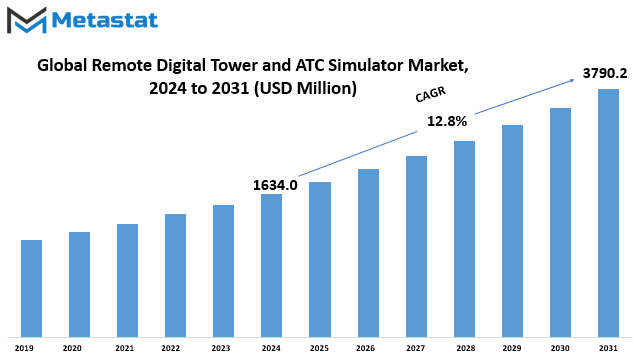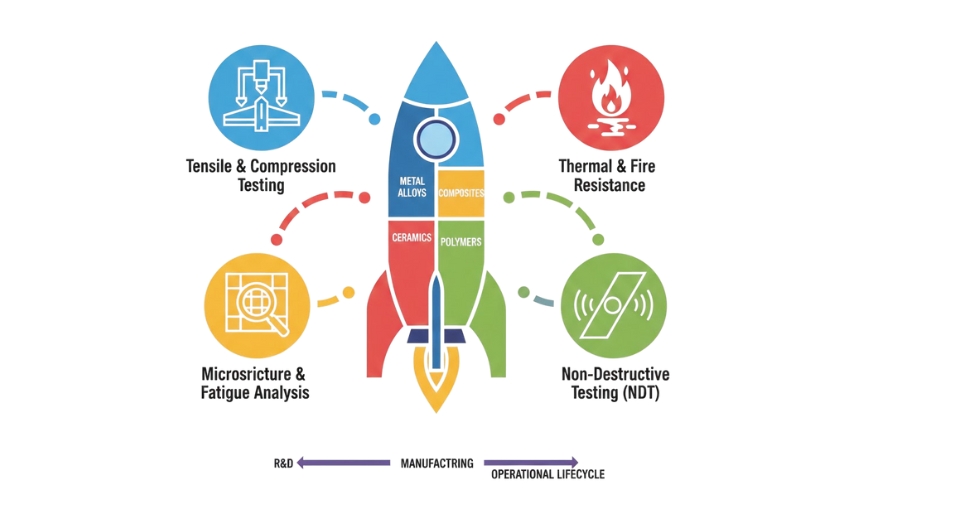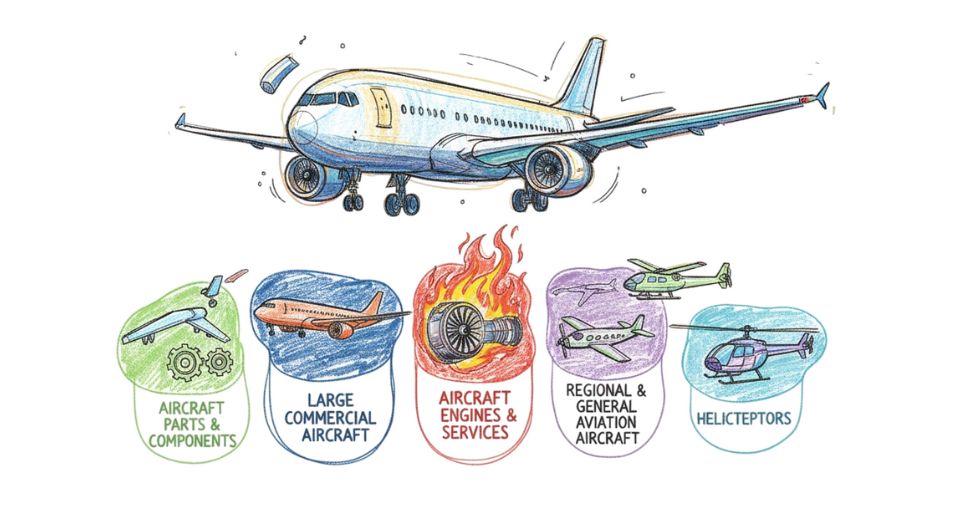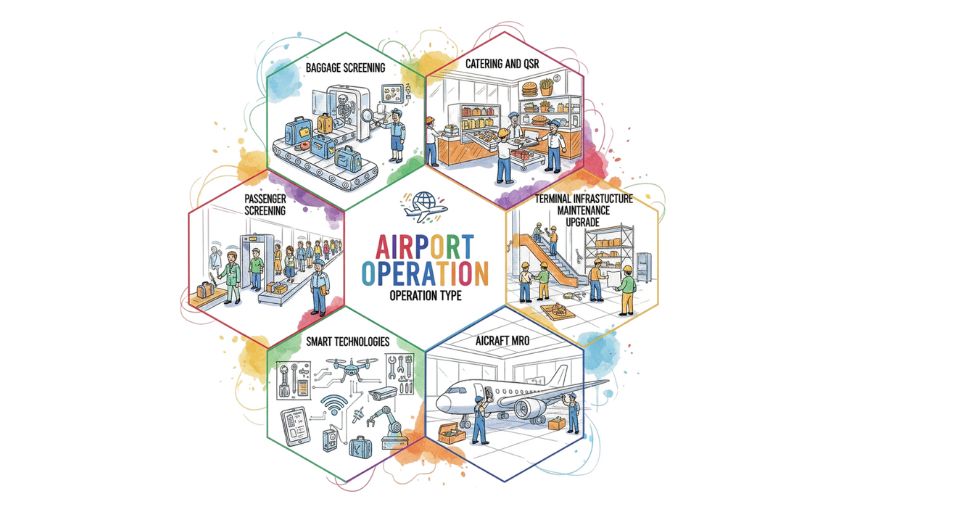MARKET OVERVIEW
The Global Remote Digital Tower and Air Traffic Control (ATC) Simulator market stands as a testament to the technological prowess reshaping the aviation industry. This innovative sector has redefined the conventional paradigms of air traffic management, ushering in a new era of efficiency and safety. As aviation continues to soar to new heights, the role of Remote Digital Towers and ATC Simulators has become increasingly pivotal.
The industry revolves around providing cutting-edge solutions for air traffic management, leveraging advanced technologies to enhance operational capabilities. Remote Digital Towers (RDT) play a central role, enabling air traffic controllers to remotely monitor and manage airports, transcending the limitations of physical presence. This breakthrough technology is a paradigm shift from the traditional tower-based approach, allowing for centralized control and streamlined coordination across multiple airports.
Complementing the Remote Digital Towers, the ATC Simulators form another integral facet of the market. These simulators serve as training grounds for air traffic controllers, offering a realistic and immersive environment to hone their skills. The simulations are designed to replicate various scenarios, from routine operations to emergency situations, providing controllers with invaluable experience in a risk-free setting. The sophistication of these simulators is a testament to the industry's commitment to ensuring the highest standards of safety and efficiency in air traffic control.
The Global Remote Digital Tower and ATC Simulator market is marked by a diverse landscape of players, ranging from established aviation technology giants to nimble startups pushing the boundaries of innovation. The competitive spirit within the industry has spurred a continuous cycle of research and development, driving the evolution of these technologies. The market's dynamism is fueled by a collective commitment to staying ahead of the curve, anticipating the ever-changing demands of the aviation landscape.
While the industry's primary focus is on improving air traffic management, its impact extends beyond operational efficiency. The adoption of Remote Digital Towers and ATC Simulators aligns with the broader global initiatives to reduce the environmental footprint of aviation. By optimizing air traffic routes and enhancing overall efficiency, these technologies contribute to minimizing fuel consumption and emissions, addressing key concerns in the contemporary discourse on sustainable aviation.
The Global Remote Digital Tower and ATC Simulator market are not without its challenges. As the industry grapples with the integration of emerging technologies, stakeholders face issues related to standardization, regulatory frameworks, and cybersecurity. The complexities inherent in developing and implementing these advanced systems underscore the need for collaborative efforts among industry players, regulators, and technology experts to overcome these hurdles.
The Global Remote Digital Tower and ATC Simulator market represent a pivotal force in reshaping the dynamics of air traffic management. Beyond the technological marvels that define this industry, its significance lies in the profound impact on safety, efficiency, and sustainability within the aviation sector. As the industry continues to forge ahead, the synergy between Remote Digital Towers and ATC Simulators promises a future where the skies are not just navigated but orchestrated with unprecedented precision and foresight.
Global Remote Digital Tower and ATC Simulator market is estimated to reach $3790.2 Million by 2031; growing at a CAGR of 12.8% from 2024 to 2031.

GROWTH FACTORS
The Global Remote Digital Tower and ATC Simulator market are experiencing significant growth, propelled by key driving factors. These factors contribute to the expansion of the market, fostering its development. Nevertheless, certain challenges may impede this growth, presenting obstacles that warrant consideration. Despite these challenges, potential opportunities emerge on the horizon, promising to enhance the market's prospects in the years to come.
The market's growth is intricately tied to a variety of factors that actively propel it forward. These factors serve as the engine driving the expansion of the Global Remote Digital Tower and ATC Simulator market. Understanding these growth factors is crucial in comprehending the market's trajectory and potential.
One such driving force is the increasing demand for advanced air traffic control (ATC) solutions. As the aviation industry continues to evolve, there is a heightened need for sophisticated technologies that can efficiently manage air traffic. The integration of remote digital towers and ATC simulators addresses this demand by providing innovative solutions that enhance operational efficiency and safety.
Furthermore, technological advancements play a pivotal role in shaping the market's growth. The continuous evolution of digital technologies contributes to the development of more advanced and efficient remote tower and ATC simulation systems. This, in turn, attracts the attention and investment of stakeholders looking to stay at the forefront of technological innovation within the aviation sector.
While the growth factors fuel the market's upward trajectory, it's essential to acknowledge the challenges that may hinder this progression. Factors such as regulatory hurdles and operational complexities pose potential obstacles to the seamless expansion of the Global Remote Digital Tower and ATC Simulator market. Regulatory frameworks in different regions may vary, requiring careful navigation to ensure compliance and successful market penetration.
Operational challenges, such as system integration issues and training requirements, also warrant attention. Overcoming these challenges necessitates a strategic approach that considers the diverse operational landscapes and requirements of the aviation industry.
Despite these impediments, the market remains resilient and poised for growth. Identifying and addressing challenges paves the way for the emergence of opportunities that can further propel the market forward. These opportunities may come in the form of collaborations, partnerships, or the development of tailored solutions that cater to specific industry needs.
Looking ahead, the Global Remote Digital Tower and ATC Simulator market are poised to capitalize on various opportunities that will shape its future landscape. Investments in research and development, coupled with strategic partnerships, will play a pivotal role in unlocking new avenues for growth. As the market continues to evolve, stakeholders must remain agile, adapting to the dynamic nature of the aviation industry to harness the full potential of the Global Remote Digital Tower and ATC Simulator market in the years to come.
MARKET SEGMENTATION
By Type
In the expansive landscape of the global aviation industry, the Global Remote Digital Tower and Air Traffic Control (ATC) Simulator market play pivotal roles in enhancing air travel safety and efficiency. This market, divided by type, encompasses Remote Digital Tower Systems, ATC 2D Simulators, and ATC 3D Simulators.
Remote Digital Tower Systems represent a cutting-edge approach to air traffic management. These systems leverage advanced technologies to provide controllers with a comprehensive view of the airfield, replacing the traditional physical tower. This transition allows for more flexible and cost effective operations while maintaining a high standard of safety.
On the other hand, ATC 2D Simulators are instrumental in training air traffic controllers. These simulators simulate a two-dimensional environment, replicating real-world scenarios that controllers might encounter. Such training environments are crucial for honing the skills of controllers, ensuring they are well-prepared to handle various situations in actual operational settings.
In the ATC 3D Simulators, we witness a technological leap. These simulators introduce an additional dimension, offering a more immersive training experience for controllers. The three-dimensional aspect enhances the realism of scenarios, enabling controllers to practice and refine their decision making abilities in a dynamic and lifelike environment.
The adoption of these technologies marks a significant shift in how air traffic control is approached globally. Remote Digital Tower and ATC Simulators contribute to increased operational efficiency, reduced costs, and improved safety measures. The aviation community benefits from enhanced training opportunities for controllers, ultimately translating to a safer and more reliable air travel system.
The market's growth is fueled by the increasing demand for modernized air traffic management solutions. Airlines, airports, and regulatory bodies recognize the importance of staying abreast of technological advancements to meet the evolving demands of the aviation landscape. The integration of Remote Digital Tower Systems and advanced ATC Simulators aligns with this forward looking approach, ensuring that the industry stays ahead in addressing the challenges of air traffic control.
As we navigate the intricacies of modern aviation, it becomes evident that these technological advancements not only address current challenges but also prepare the industry for the future. The market’s segmentation into Remote Digital Tower Systems, ATC 2D Simulators, and ATC 3D Simulators reflects the diverse approaches taken to enhance air traffic control capabilities. This diversity ensures that stakeholders have a range of tools at their disposal, tailored to their specific needs and operational contexts.
The Global Remote Digital Tower and ATC Simulator market represent a dynamic landscape where innovation meets the practical demands of air traffic management. The adoption of Remote Digital Tower Systems and advanced ATC Simulators signifies a shift toward more efficient, cost-effective, and safer air travel operations. As the industry continues to evolve, these technologies will undoubtedly play a pivotal role in shaping the future of air traffic control.
By Application
The global market for Remote Digital Tower and Air Traffic Control (ATC) Simulators is segmented based on its applications. These applications include Civil Airports, Military Airports, Emergency Services, and Research & Training Institutes.
Civil Airports play a crucial role in the functioning of the aviation industry. These airports cater to commercial flights, serving as hubs for passenger travel. The Remote Digital Tower and ATC Simulators find application in enhancing the efficiency and safety of air traffic control at civil airports. This technology aids in managing the flow of flights, ensuring smooth take-offs and landings, and overall contributing to the operational prowess of these airports.
Military Airports, on the other hand, have specific requirements distinct from civil airports. They often handle military aircraft, necessitating specialized air traffic control measures. Remote Digital Tower and ATC Simulators are instrumental in meeting these requirements by providing advanced simulation capabilities tailored to military aviation needs. This application ensures effective coordination and control of military aircraft movements, contributing to the security and operational effectiveness of military airports.
Emergency Services represent another critical facet of the Remote Digital Tower and ATC Simulator market. In times of crises or emergencies, efficient air traffic control becomes paramount. Whether it’s coordinating medical evacuation flights or managing airspace during natural disasters, these simulators aid emergency services in maintaining control and ensuring the swift and safe movement of aircraft.
Research & Training Institutes form a significant application area for Remote Digital Tower and ATC Simulators. These institutes focus on training future air traffic controllers and conducting research to enhance air traffic management practices. The simulators offer a realistic training environment, allowing aspiring controllers to hone their skills in a controlled setting. Additionally, research institutes utilize these simulators to analyze and develop innovative solutions for improving overall air traffic control systems.
The market for Remote Digital Tower and ATC Simulators is diverse, catering to various applications within the aviation sector. Civil Airports benefit from enhanced efficiency, Military Airports gain specialized control capabilities, Emergency Services ensure swift response during critical situations, and Research & Training Institutes utilize the technology for educating and advancing the field of air traffic control. This segmentation reflects the adaptability and wide-ranging impact of Remote Digital Tower and ATC Simulators across different sectors of the aviation industry.

By End User
The Global Remote Digital Tower and ATC Simulator market exhibit a diversified landscape, with distinct segments catering to various end users. Among these end users, we find Air Traffic Control Authorities, Airport Operators, Defense Organizations, and Training Centers.
Air Traffic Control Authorities play a pivotal role in ensuring the safe and efficient movement of air traffic. They rely on advanced technologies like Remote Digital Towers to enhance their capabilities. This modern approach allows them to manage air traffic remotely, utilizing digital systems that provide real-time information and improve decision-making.
Airport Operators, another significant player in this market, benefit from Remote Digital Towers by enhancing their overall operational efficiency. These systems provide a comprehensive view of the airport, aiding in monitoring and managing various activities. By employing such technology, Airport Operators streamline processes, resulting in smoother and more organized airport operations.
Defense Organizations find value in the Global Remote Digital Tower and ATC Simulator market as well. The advanced simulation capabilities of these systems enable Defense Organizations to train their personnel effectively. This not only ensures readiness in handling complex scenarios but also contributes to the overall safety and security of airspace.
Training Centers represent a crucial sector in the market, focusing on preparing individuals for roles within air traffic management. The integration of ATC simulators allows these centers to provide realistic training scenarios, giving trainees a hands-on experience in a controlled environment. This immersive training approach proves instrumental in developing the skills required for managing air traffic efficiently.
The market’s segmentation based on end users reflects the diverse applications of Remote Digital Towers and ATC Simulators. Each segment addresses specific needs within the broader aviation ecosystem, contributing to the overall advancement of air traffic management.
The Global Remote Digital Tower and ATC Simulator market play a pivotal role in shaping the future of air traffic management. The involvement of key stakeholders such as Air Traffic Control Authorities, Airport Operators, Defense Organizations, and Training Centers underscores the widespread adoption of advanced technologies to ensure safer and more efficient air travel. As these technologies continue to evolve, they bring about positive transformations in the way we approach and manage air traffic, ultimately contributing to a more secure and streamlined aviation industry.
REGIONAL ANALYSIS
In examining the Global Remote Digital Tower and ATC Simulator market from a geographical perspective, we can observe its division into North America, Europe, Asia-Pacific, Latin America, and the Middle East and Africa. This regional analysis offers insights into the market dynamics across different parts of the world.
North America, as one of the key regions, plays a significant role in shaping the trajectory of the Remote Digital Tower and ATC Simulator market. With advanced technological infrastructure and a robust aviation sector, the demand for these solutions is notable. The region's commitment to innovation and efficiency further propels the adoption of such advanced air traffic control technologies.
Moving across the Atlantic, Europe emerges as another vital player in this market landscape. The continent's diverse aviation landscape, marked by major airports and a dense air traffic network, fuels the need for sophisticated tower and ATC simulation systems. The emphasis on safety and precision in air traffic management makes these solutions pivotal in the European aviation sector.
Venturing into the dynamic Asia-Pacific region, we encounter a burgeoning aviation industry and a growing focus on modernizing air traffic control. Countries like China and India, with their expanding aviation infrastructure, contribute significantly to the demand for Remote Digital Tower and ATC Simulator technologies. The increasing air travel in the region necessitates cutting-edge solutions to manage the escalating traffic.
Latin America, characterized by a mix of developed and emerging economies, also witnesses a surge in the adoption of these technologies. As the aviation sector in the region undergoes expansion and upgrades, the demand for advanced tower and ATC simulation solutions rises. The pursuit of efficiency and safety in air travel propels the market forward in this part of the world.
Turning attention to the Middle East and Africa, we find a region marked by diverse aviation landscapes. The presence of major international airports and a growing aviation sector in certain countries contributes to the demand for Remote Digital Tower and ATC Simulator technologies. As these nations strive for enhanced air traffic management capabilities, the market gains traction.
The regional analysis of the Global Remote Digital Tower and ATC Simulator market unveils a nuanced picture of its dynamics. From the technological prowess of North America to the diverse aviation landscapes of Europe, Asia-Pacific, Latin America, and the Middle East and Africa, each region contributes uniquely to the growing demand for advanced air traffic control solutions. This global market, shaped by regional intricacies, reflects the evolving needs of the aviation industry worldwide.
COMPETITIVE PLAYERS
In the dynamic landscape of the Global Remote Digital Tower and Air Traffic Control (ATC) Simulator market, various noteworthy contenders are actively contributing to its growth. Among these contributors, the Saab Group emerges as a key player, shaping the industry’s trajectory.
Saab Group, a prominent entity in the Remote Digital Tower and ATC Simulator sector, plays a pivotal role in influencing market dynamics. Its strategic initiatives and technological prowess position it as a significant force, impacting the industry’s overall competitiveness. As the market evolves, Saab Group’s role becomes even more pronounced, reflecting its adaptability and commitment to staying at the forefront of advancements.
In the Remote Digital Tower and ATC Simulator solutions, Saab Group’s influence extends beyond mere participation. The company’s commitment to innovation underscores its dedication to addressing the evolving needs of the industry. This commitment is evident in its continuous efforts to enhance the capabilities of its offerings, ensuring they align seamlessly with the changing landscape of air traffic control and management.
Saab Group’s impact is not limited to technological innovation alone. The company’s strategic positioning and market insights contribute significantly to the competitive dynamics of the sector. By staying attuned to market trends and customer requirements, Saab Group positions itself as a reliable partner for stakeholders seeking cutting-edge solutions in the realm of Remote Digital Tower and ATC Simulators.
In the context of the broader industry landscape, the presence of key players like Saab Group fosters healthy competition. This competition acts as a catalyst for innovation, propelling the industry forward. Saab Group’s involvement in this competitive milieu creates an environment where each player strives to enhance their offerings, thereby benefiting end-users and elevating the overall quality of Remote Digital Tower and ATC Simulator solutions.
The significance of Saab Group’s role in the industry is not merely confined to its market presence. The company’s commitment to ethical business practices and customer satisfaction contributes to the overall integrity of the Remote Digital Tower and ATC Simulator market. In an environment where trust and reliability are paramount, Saab Group’s adherence to high standards sets a positive tone for the industry, fostering a climate of confidence among stakeholders.
As the Remote Digital Tower and ATC Simulator market continues to evolve, Saab Group’s influence is poised to remain integral. The company’s ability to navigate the complexities of the industry and provide innovative solutions positions it as a key driver of progress. Through its sustained commitment to excellence, Saab Group exemplifies the spirit of collaboration and competition that defines the contemporary landscape of Remote Digital Tower and ATC Simulators.
Saab Group’s role as a key player in the Global Remote Digital Tower and ATC Simulator market is characterized by its commitment to innovation, strategic positioning, and ethical business practices. As the industry continues to advance, Saab Group’s impact is likely to shape the trajectory of Remote Digital Tower and ATC Simulator solutions, contributing to the overall vibrancy and competitiveness of the market.
Remote Digital Tower and ATC Simulator Market Key Segments:
By Type
- Remote Digital Tower Systems
- ATC 2D Simulator
- ATC 3D Simulator
By Application
- Civil Airports
- Military Airports
- Emergency Services
- Research & Training Institutes
By End User
- Air Traffic Control Authorities
- Airport Operators
- Defense Organizations
- Training Centers
Key Global Remote Digital Tower and ATC Simulator Industry Players
- Saab Group
- Indra Sistemas S.A.
- Adacel Technologies Limited
- Raytheon Technologies Corporation
- Micro Nav Limited
- ELDIS Pardubice, s.r.o
- UFA, Inc.
- NATS Limited
- Searidge Technologies
- Frequentis Group
WHAT REPORT PROVIDES
- Full in-depth analysis of the parent Industry
- Important changes in market and its dynamics
- Segmentation details of the market
- Former, on-going, and projected market analysis in terms of volume and value • Assessment of niche industry developments
- Market share analysis
- Key strategies of major players
- Emerging segments and regional growth potential








 US: +1 3023308252
US: +1 3023308252






